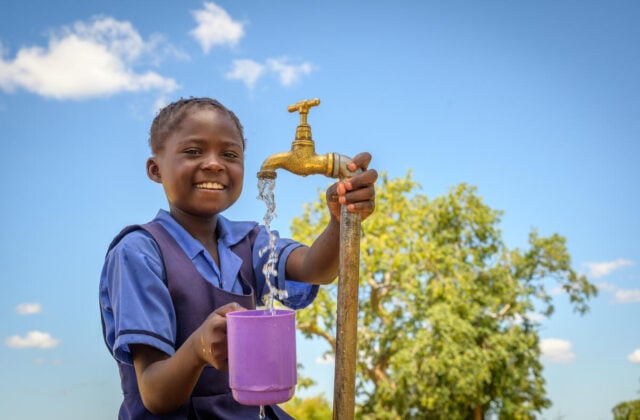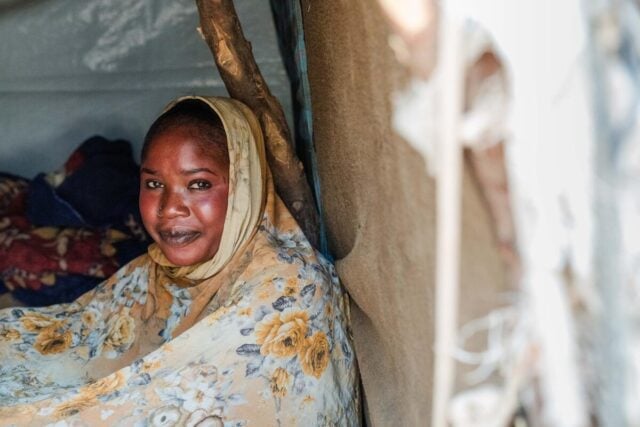In sub-Saharan Africa, 319 million people worry about where and how they’ll get enough water. Without access to an improved water source, their days revolve around a walk for water: gathering enough to cook, clean, bathe — and of course, drink.
The task of collecting water falls mainly to women and children, especially girls, who carry water an average of 6 kilometers (3.7 miles) a day. Some walk much farther, while others — especially those living in a community where World Vision has sponsorship programs — walk far less.
Meet two of them: Cheru and Kamama. Both 5-year-olds live in rural Kenya, and like millions of African children, they help their mothers carry water every day. Though they live just 16 miles apart, for one, getting water is a three-hour struggle; for the other, it’s a seven-minute stroll.
Walk with them.
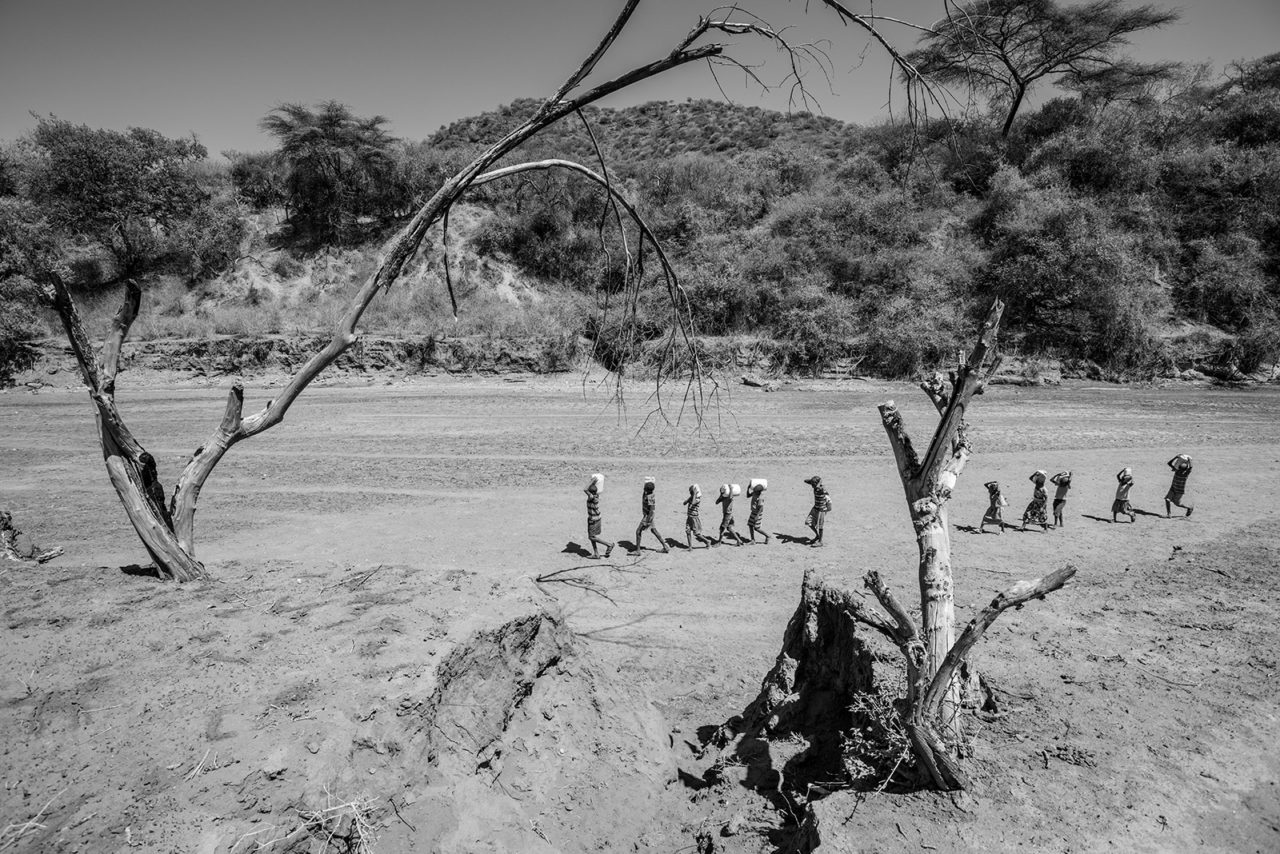
Cheru walks for dirty water
- Age: 5
- Location: West Pokot County, Kenya
- Distance to water: 6.88 kilometers, or 4.27 miles, round trip
- Time spent on each trip: 3 hours, 32 minutes
Cheru drinks the last of her warm milk tea — her usual breakfast — and hands the tin cup to her mother, Monica, to wash.
Her older sister, Dina, waits for her, jerrycan in hand. Cheru stands on tiptoe to pull down the tea kettle hanging on the side of a woven wood stand where clean dishes dry in the sun. The girls hurry to join other children with jerrycans large and small, and the group sets out walking on a hours-long journey to get the water their families’ lives depend on.
The sun climbs higher and hotter in the clear sky as if to melt the sand and rocks of the dry Kesot River bed. Slowing their pace, the children, ranging in age from 5 to 12, skirt the bluffs and linger in the shade of trees.
Sweat beading on her forehead, Cheru falls behind. She stops, swaps the kettle to her other hand, and plunges ahead to catch up at the next resting place. The youngest of the group, Cheru follows the older children and tries to do what they do.
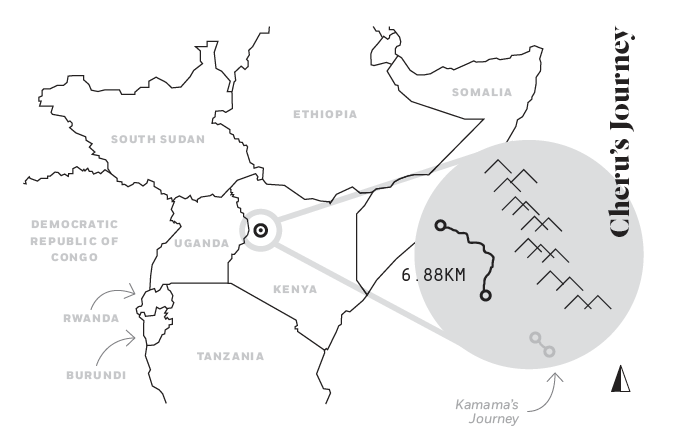
At the waterhole
Cheru’s battered aluminum tea kettle holds enough water for her morning tea, but little more. When she digs in the sandy riverbed with the lid and scoops enough water to fill her kettle, it’s not enough to cook a meal or wash dishes.
Even at age 5, Cheru knows that her mother worries about water and struggles to carry enough for their daily needs, though she makes the round trip trek twice a day. So every day, the little girl picks up her kettle and walks to fill it. “I help my mother,” she says.
Dina, 6, can dig faster and fill her jerrycan with more water. She’s impatient and pushes Cheru out of the way. They’ve had to wait for a turn to dig, and others are waiting to take their place. Goats, cows, and camels jockey for position, too. The little girl starts to cry.
Children don’t get the best places to dig. There’s a larger, more productive waterhole 50 yards further on. There, women fill jerrycans, bathe their babies, wash clothes, and watch their cattle drink.
The driest time of year is coming, bringing months when there is no rain. As water becomes more scarce, the fiercest competitors — wild honeybees — dominate the waterholes during the day, threatening to sting intruders. The bees gather anywhere there’s moisture, even clustering around a child’s runny nose or in the corner of their eyes, says Monica.
As it gets drier, digging becomes serious business for adults. They’ll dig deep, some years going down 20 feet, hauling up filled jerrycans with a rope until the waterholes yield no water, only sand. The holes can cave in on people who are digging, and animals sometimes fall in and drown.
“When there’s no water here, we go to the dam,” says Samson, Cheru’s father. They walk more than six miles to take water from a crocodile-infested river.
The children’s walk for water
But today, there’s water for the digging and the bees are buzzing elsewhere. When the children’s jerrycans are filled, they start the trek home. Some tie a long scarf around the handle and support the weight of the jerrycan with their foreheads. Others balance a jug on their head or shoulders. Cheru swaps her tea kettle from one hand to the other and plods along.
In every shady place, the children stop to put down their heavy water jugs and rest. It’s a school holiday, so they take their time. No parents are along to rush them.
When the new school session starts, the children will hurry to the waterhole early, before the bees come in full force. They’ll fill their jerrycans with the water they need for the school day and walk to class. After classes, they’ll stop by the water hole to get water to take home. The distance is more than 6 kilometers, the average daily distance women and girls in the developing world walk for water.
“When it’s very dry, it’s hard for kids to get to school,” Monica says. “They have to wait too long at the waterhole or take care of the younger kids while their mothers spend the whole day to fetch water from far away.” Monica worries that Cheru won’t be able to keep up for the long walk.
“If we had water here, they would attend school without fail,” says Samson.
The effects of this life mean Cheru and so many other girls and women are not able to live up to their potential. Every day is shaped by the walk for water.
‘If we had water’
“I think about water more than anything else,” says Monica. She’s always wondering: Do I have enough water to cook a meal, to make tea, and to wash clothes? Is there enough for the goats?
Villagers have agreed to take their goat herds to the waterhole on alternate days, so they have to carry home enough water for them, too. Seated in the shade of a kitchen hut, Monica and other women from the village imagine what it would be like to have water close at hand.
“If we had water,” says one villager, Rael, “we would have time for other things. We would grow vegetables and go out to do business.”
The rainy season has just passed and with it their chance to make an annual crop. Says Rael, “We grew maize in a field by the riverbank, but it dried up. Now we’ll have to buy maize.”
If we had water, the women say: “We could grow bananas, sugar cane, cabbages.”
“Our children wouldn’t have to carry water to school.”
“They would be clean and not get sick from drinking dirty water.”
Monica says hardly a week goes by before a child in her family gets sick.
“Cheru was sick three weeks ago. She was very sick,” Monica says. The little girl had stomach problems, headache, nosebleed, and bloody stool. She was weak and listless. Luckily, the closest health center was open. (It’s often closed for months.) She still has a runny nose, rheumy eyes, and a deep, congested cough.
Even as a child, Cheru’s daily life is consumed with finding water. The effects of this life — poverty, illness, malnutrition, and inadequate education — mean that Cheru and so many other girls and women are not able to live up to their potential. Every day is shaped by the walk for water.
What is Cheru’s life like now?
Kamama has choices because of clean water
- Age: 5
- Location: West Pokot County, Kenya
- Distance to water: 252 yards, or .14 miles, round trip
- Time spent on each trip: 6 minutes, 49 seconds
Barely 16 miles away lives another 5-year-old girl, Kamama, whose life is very different from Cheru’s. She and three siblings are World Vision sponsored children — and where World Vision brings clean water and child sponsorship, a cascade of blessings follow: fewer illnesses, better nutrition, more kids in school, and time for moms and dads to farm or run a business.
In 2015, World Vision — along with community members including Kamama’s mother, Julia — tapped a mountain spring and piped water down to their community. Everything has been different since then.
Kamama’s family and their neighbors have experienced the transformation that clean water brings. Their 13-mile-long gravity-fed pipeline carries water to 15 kiosks, serving 880 households as well as schools, churches, and a health center. World Vision runs the system, but local committees manage the kiosks and are preparing to take over maintenance, too, funded by a small monthly fee for users.
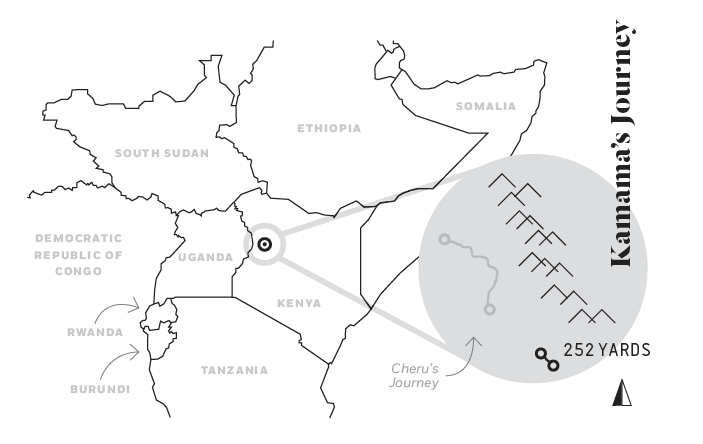
Paving the way for progress
Like Cheru, Kamama helps her mother by carrying a small jerrycan — or even the family’s tea kettle — to easily bring water from the nearest source. She can fill her kettle with clean water from a kiosk and return home in less than seven minutes, a round trip of 252 yards. She doesn’t have to compete with cattle and goats who dirty the water; the animals drink from their own water trough, away from the village water supply.
Kamama and her friends like to meet at the kiosk to play, just yards from where their mothers are drawing water, washing clothes, or hanging laundry on the cactus fence that lines the dirt road.
“Before, I walked for three hours to collect water from the river,” says Julia. “Now it’s just a few minutes to the kiosk.”
The responsibility for providing for her children falls solely on Julia. Tragedy struck the family in 2014 when her husband, Daudi, was killed in a road accident. Julia worried that she wouldn’t be able to keep the children in school, which had been her husband’s dream for them.
“On my own, I knew I had to work extra hard. First, I work to grow maize, fruit, and other crops we can eat and sell. Then I pick up other work, too,” says Julia.
World Vision and the family’s church helped keep them afloat and boosted her courage.
“When discouraged and things felt very difficult, I thought about God’s plan,” says Julia. “God has a plan for us. And in that plan, I need to manage for my family. I have authority.”
‘Water has changed everything’
The effects of the water project flow through the village. Clean water runs from the faucet in the community health center’s lab, and it’s piped straight to the school and sprinkled on the children’s demonstration garden. It has changed family life in fundamental ways.
“Life became much easier when the water came. We save time, too. I have more time for farming,” Julia says. She and her children tend maize, beans, millet, and lush fruit trees heavy with mangoes, oranges, lemons, and guavas. They have maize to eat from their harvest, even in a year with low rainfall.
Samuel Lemungole, lab technician at the local health center, remembers the days when he’d arrive at work to find 10 people waiting, very sick.
“I’d test and find that it was typhoid. Now we seldom see that. Diarrhea and other waterborne diseases are way down,” he says. “Water has changed everything for the better.”
Good health comes not just from piped water to drink, but also from using toilets, taking baths, and washing hands. World Vision trains village health volunteers who teach others to construct and maintain toilets. World Vision WASH (water, sanitation, and hygiene) clubs in the primary school teach health and hygiene.
Education is stronger than ever, too. Enrollment at the local primary school increased from 200 to 500 students in the two years since water came. Students grow a demonstration garden in the schoolyard, full of tomatoes, sukuma wiki (collards), and other greens. “It’s our outdoor classroom,” says Korio John, their teacher. “They learn science, nutrition, culture, life skills. The garden is perfect for developing the whole child.”
Kamama is in her second year of school. She goes every day with her best friends, Ktum and Safari, who live next door. “She can go to school early and study well, wear clean clothes, and not be tired or sick,” says her mother proudly. “To drink clean water and keep your children clean, this is a good life.”
Every child deserves clean water.
Clean water is the key to their hopes and dreams
Kamama and Cheru seem further apart than the few miles that separate them. Already there’s an alarming difference in their lives, and the gap between their prospects for the future will only widen unless Cheru gains easy access to clean water.
Cheru’s family can hardly imagine the “good life” they could have if not for the daily struggle to meet their basic needs — especially the miles-long walk for water. They dream about what life could be like if water, education, healthcare, and income opportunities were available.
For Kamama’s family, meeting daily needs requires work, but it’s manageable. The water system lifted a burden, and sponsorship means the children can play, study, laugh, and dream about what their future holds. It’s the difference of 16 miles — and clean water.

